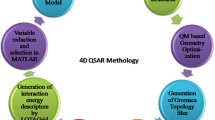Abstract
Anti-HIV compounds comprise inhibitors of some different biological targets, like HIV protease, integrase and reverse transcriptase enzymes, and entry and fusion proteins. These drugs are usually administered in drug cocktails (AIDS cocktails); the use of a single multi-target anti-HIV-1 compound against AIDS would avoid a more exhaustive therapeutic treatment. The QSAR modeling of reverse transcriptase inhibitors and anti-HIV-1 compounds in general is reported and, given some substructural similarity between the compounds of these two classes, novel compounds with possible double action against HIV-1 were proposed and their bioactivities estimated using the QSAR model. Docking studies were also developed to validate the QSAR predictions, as well as to understand the mode of interaction of the proposed compounds and to compute the docking scores of some derivatives (not predictable using the QSAR model) in the active site of HIV reverse transcriptase.






Similar content being viewed by others
References
ACD (2006) ACD/CHEMSKETCH, version 10.02. Advanced Chemistry Development Inc., Toronto
Chan JH, Hong JS, Hunter RN III, Orr GF, Cowan JR, Sherman DB, Sparks SM, Reitter BE, Andrews CW III, Hazen RJ, St Clair M, Boone LR, Ferris RG, Creech KL, Roberts GB, Short SA, Weaver K, Ott RJ, Ren J, Hopkins A, Stuart DI, Stammers DK (2001) 2-Amino-6-arylsulfonylbenzonitriles as non-nucleoside reverse transcriptase inhibitors of HIV-1. J Med Chem 44:1866–1882
Cormanich RA, Freitas MP, Rittner R (2011) 2D chemical drawings correlate to bioactivities: MIA–QSAR modelling of antimalarial activities of 2,5-diaminobenzophenone derivatives. J Braz Chem Soc 22:637–642
Cormanich RA, Nunes CA, Freitas MP (2012) Chemical drawings correlate to biological properties: MIA–QSAR. Quim Nova 35:1157–1163
Freeman GA, Shaver SR, Rideout JL, Short SA (1995) 2-Amino-9-(3-azido-2,3-dideoxy-beta-d-erythro-pentofuranosyl)-6-substituted-9H-purines—synthesis and anti-HIV activity. Bioorg Med Chem 3:447–458
Freitas MP, Brown SD, Martins JA (2005) MIA–QSAR: a simple 2D image-based approach for quantitative structure–activity relationship analysis. J Mol Struct 738:149–154
Golbraikh A, Tropsha A (2002) Beware of q 2! J Mol Graph Model 20:269–276
Hammett LP (1937) The effect of structure upon the reactions of organic compounds. Benzene derivatives. J Am Chem Soc 59:96–103
Kumar S, Singh V, Tiwari M (2011) QSAR modeling of the inhibition of reverse transcriptase enzyme with benzimidazolone analogs. Med Chem Res 20:1530–1541
Lipinski CA, Lombardo F, Dominy BW, Feeney PJ (1997) Experimental and computational approaches to estimate solubility and permeability in drug discovery and development settings. Adv Drug Del Rev 23:4–25
MathWorks Inc. (2007) MATLAB, version 7.5. MathWorks Inc., Natick
Mitra I, Saha A, Roy K (2010) Exploring quantitative structure–activity relationship studies of antioxidant phenolic compounds obtained from traditional Chinese medicinal plants. Mol Simul 36:1067–1079
Moda TL, Torres LG, Carrara AE, Andricopulo AD (2005) PK/DB: database for pharmacokinetic properties and predictive in silico ADME models. Bioinformatics 24:2270–2271
Ojha PK, Mitra I, Das RN, Roy K (2011) Further exploring r 2m metrics for validation of QSPR models. Chemom Intell Lab Syst 107:194–205
Pinheiro J, Bitencourt M, da Cunha FFF, Ramalho TC, Freitas MP (2008) Novel anti-HIV cyclotriazadisulfonamide derivatives as modeled by ligand- and receptor-based approaches. Bioorg Med Chem 16:1683–1690
Roy PP, Paul S, Mitra I, Roy K (2009) On two novel parameters for validation of predictive QSAR models. Molecules 14:1660–1701
Roy K, Mitra I, Kar S, Ojha PK, Das RN, Kabir H (2012) Comparative studies on some metrics for external validation of QSPR models. J Chem Inf Model 52:396–408
Vermeire K, Bell TW, Choi HJ, Jin Q, Samala MF, Sodoma A, De Clercq E, Schols D (2003) The anti-HIV potency of cyclotriazadisulfonamide analogs is directly correlated with their ability to down-modulate the CD4 receptor. Mol Pharmacol 63:203–210
Vilar S, Santana L, Uriarte E (2006) Probabilistic neural network model for the in silico evaluation of anti-HIV activity and mechanism of action. J Med Chem 49:1118–1124
World Health Organization (2012) http://www.who.int/hiv/data/2012_epi_core_en.png. Accessed 02 Feb 2013
Acknowledgments
Authors are thankful to Fundação de Amparo à Pesquisa do Estado de Minas Gerais (FAPEMIG) for the financial support, as well as to Coordenação de Aperfeiçoamento de Pessoal de Nível Superior (CAPES) for studentships (to E.G.M. and D.G.S.) and to Conselho Nacional de Desenvolvimento Científico e Tecnológico (CNPq) for a studentship (to M.C.G.) and fellowships (to E.F.F.C. and M.P.F.).
Author information
Authors and Affiliations
Corresponding author
Rights and permissions
About this article
Cite this article
Guimarães, M.C., Silva, D.G., da Mota, E.G. et al. Computer-assisted design of dual-target anti-HIV-1 compounds. Med Chem Res 23, 1548–1558 (2014). https://doi.org/10.1007/s00044-013-0765-3
Received:
Accepted:
Published:
Issue Date:
DOI: https://doi.org/10.1007/s00044-013-0765-3




